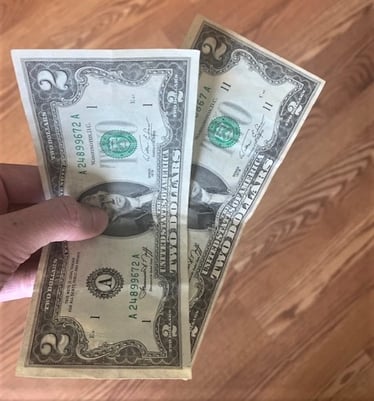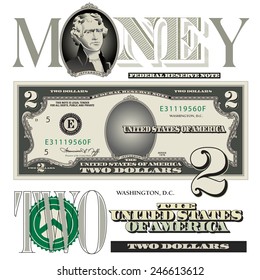The present denominations of our currency in production are $1, $2, $5, $10, $20, $50 and $100. The purpose of the United States currency system is to serve the needs of the public and these denominations meet that goal. Neither the Department of the Treasury nor the Federal Reserve System has any plans to change the denominations in use today. The United States two-dollar bill ($2) is a current denomination of United States currency. A portrait of Thomas Jefferson, the third President of the United States (1801–09), is featured on the obverse of the note. The reverse features an engraving of the painting Declaration of Independence by John Trumbull.
What Are 2 Dollar Bills Worth Today
ProductsAll of our MoneyPadshave 25 sheets of REAL money.| Our $1 billMoneyPad is very popular, especially as a gift for kids. $25is a good amount to give to kids, and this way they have more trouble spendingit all in one place. These are greatgifts to give at a bachelor party. The groom can have his tipping moneyin one handy pack. And girls love a man with a MoneyPad. This pad ofone dollar bills is only $39.99. That includes shipping and handlingand a coversheet that allows you to personalize the gift. Orderone today! |
My personalfavorite is the pad of $2 bills. I often run into people who thinka regular $2 billis fake, so when you rip one off a pad and hand it to them, they reallycan't believe it is genuine money. Here is anamusing story about a clueless clerk and a $2 bill. If you like pranks and tricks, this pad is for you. In addition,$2 is a good amount to tip for many things. Tearing one off the padfor the pizza guy is fun. And I know my barber likes his tip better'from the pad' than from the change (that's no fun!) A pad of twodollar bills only costs $75.99, including shipping and handling. And all of our MoneyPads come with your choice of coversheet. Ordera $2 MoneyPad. |
The US Dollar is the currency of United States. Our currency rankings show that the most popular United States Dollar exchange rate is the USD to EUR rate. The currency code for Dollars is USD, and the currency symbol is $. Below, you'll find US Dollar rates and a currency converter. You can also subscribe to our currency newsletters with daily rates and analysis, read the XE Currency Blog, or take USD rates on the go with our XE Currency Apps and website. More info ►
Top USD Exchange Rates
Currency Facts
Name: US Dollar
Symbol: $ cent: ¢
Minor Unit:
1/100 = cent
Central Bank Rate: 2.00

2 Dollar Mouse
Top USD Conversion:
USD/EUR
Top USD Chart:
USD/EUR Chart
Inflation: 2.10%
Nicknames:greenback, buck, green, dough, smacker, bones, dead presidents, scrillas, paper
2 Dollar Movie Theater
Coins:
Freq Used: 1¢, 5¢, 10¢, 25¢
Rarely Used: $1, 50¢
Banknotes:
Freq Used: $1, $5, $10, $20, $50, $100
Rarely Used: $2
Central Bank:
Federal Reserve Bank
Website: http://www.federalreserve.gov
Users: United States, America, American Samoa, more ...
Have more info about the US Dollar?Email us ►
XE Currency Converter

Why are you interested in the USD?
US Dollar History
The US central bank is called the Federal Reserve Bank (commonly referred to as 'The Fed'). The USD is the most traded currency in the forex market and can be paired with all other major currencies. Common names for the USD include the greenback, buck, green, dough, smacker, bones, dead presidents, scrillas, and paper.
Importance of the US Dollar
The US Dollar is the most commonly converted currency in the world and is regularly used as a benchmark in the Forex market. As the dominant global reserve currency, it is held by nearly every central bank in the world. Additionally, the Dollar is used as the standard currency in the commodity market and therefore has a direct impact on commodity prices.

Dollarization of the USD
Due to its international acceptance, some countries like Panama and Ecuador use the USD as an official legal tender, a practice known as dollarization. For other countries the Dollar is an accepted alternative form of payment, though not an official currency for the country. Multiple currencies are pegged to the US Dollar:
| Country | Peg Rate |
| Aruban or Dutch Guilder | 1.79000 |
| Bahamian Dollar | 1.00000 |
| Bahraini Dinar | 0.37690 |
| Barbadian Dollar | 2.00000 |
| Belizean Dollar | 2.00000 |
| Bermudian Dollar | 1.00000 |
| Cayman Island Dollar | 0.82000 |
| Cuban Convertible Peso | 1.00000 |
| Djiboutian Franc | 177.721 |
| Dutch Guilder | 1.79000 |
| East Caribbean Dollar | 2.70000 |
| Eritrean Nakfa | 15.0000 |
| Hong Kong Dollar | 7.80000 |
| Jordanian Dinar | 0.70900 |
| Lebanese Pound | 1507.50 |
| Omani Rial | 0.38450 |
| Panamanian Balboa | 1.00000 |
| Qatari Riyal | 3.64000 |
| Saudi Arabian Riyal | 3.75000 |
| United Arab Emirati Dirham | 3.67250 |
| Venezuelan Bolivar | 6.30000 |

2 Dollar Mouse
Top USD Conversion:
USD/EUR
Top USD Chart:
USD/EUR Chart
Inflation: 2.10%
Nicknames:greenback, buck, green, dough, smacker, bones, dead presidents, scrillas, paper
2 Dollar Movie Theater
Coins:
Freq Used: 1¢, 5¢, 10¢, 25¢
Rarely Used: $1, 50¢
Banknotes:
Freq Used: $1, $5, $10, $20, $50, $100
Rarely Used: $2
Central Bank:
Federal Reserve Bank
Website: http://www.federalreserve.gov
Users: United States, America, American Samoa, more ...
Have more info about the US Dollar?Email us ►
XE Currency Converter
Why are you interested in the USD?
US Dollar History
The US central bank is called the Federal Reserve Bank (commonly referred to as 'The Fed'). The USD is the most traded currency in the forex market and can be paired with all other major currencies. Common names for the USD include the greenback, buck, green, dough, smacker, bones, dead presidents, scrillas, and paper.
Importance of the US Dollar
The US Dollar is the most commonly converted currency in the world and is regularly used as a benchmark in the Forex market. As the dominant global reserve currency, it is held by nearly every central bank in the world. Additionally, the Dollar is used as the standard currency in the commodity market and therefore has a direct impact on commodity prices.
Dollarization of the USD
Due to its international acceptance, some countries like Panama and Ecuador use the USD as an official legal tender, a practice known as dollarization. For other countries the Dollar is an accepted alternative form of payment, though not an official currency for the country. Multiple currencies are pegged to the US Dollar:
| Country | Peg Rate |
| Aruban or Dutch Guilder | 1.79000 |
| Bahamian Dollar | 1.00000 |
| Bahraini Dinar | 0.37690 |
| Barbadian Dollar | 2.00000 |
| Belizean Dollar | 2.00000 |
| Bermudian Dollar | 1.00000 |
| Cayman Island Dollar | 0.82000 |
| Cuban Convertible Peso | 1.00000 |
| Djiboutian Franc | 177.721 |
| Dutch Guilder | 1.79000 |
| East Caribbean Dollar | 2.70000 |
| Eritrean Nakfa | 15.0000 |
| Hong Kong Dollar | 7.80000 |
| Jordanian Dinar | 0.70900 |
| Lebanese Pound | 1507.50 |
| Omani Rial | 0.38450 |
| Panamanian Balboa | 1.00000 |
| Qatari Riyal | 3.64000 |
| Saudi Arabian Riyal | 3.75000 |
| United Arab Emirati Dirham | 3.67250 |
| Venezuelan Bolivar | 6.30000 |
Introduction of the US Dollar
In 1785, the Dollar was officially adopted as the money unit of the United States. The Coinage Act of 1792 created the first U.S. Mint and established the federal monetary system, as well as set denominations for coins specified by their value in gold, silver, and copper. In 1861, the U.S. Treasury issued non-interest-bearing Demand Bills and the very first $10 Demand Bills, featuring Abraham Lincoln, went into circulation. These bills quickly earned the nickname 'Greenbacks' because of their color. In 1863, a national banking system was established and guidelines for national banks were created. These banks were authorized to issue national currency secured by the purchase of US bonds. In 1914, the first $10 Federal Reserve notes were issued.
Silver and Gold Standard in the US
For years, the United States attempted to make a bimetallic standard, starting by adopting a silver standard based on the Spanish Milled Dollar in 1785. However, silver coins soon left circulation becoming completely suspended by 1806. By this time, most countries had already begun to standardize transactions by adopting the gold standard, meaning that any paper money could be redeemed by the government for its value in gold. The Bretton-Woods system was adopted by most countries to set the exchange rates for all currencies in terms of gold. Since the United States held most of the world's gold, many countries simply pegged the value of their currency to the Dollar. Central banks maintained fixed exchange rates between their currencies and the Dollar, turning the US Dollar into the de facto currency of the world. In 1973, the US finally decoupled the value of the Dollar from gold completely.
